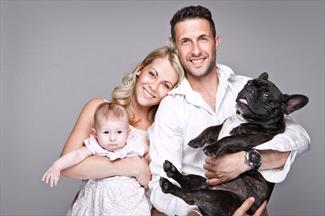Baby, dog and family

Photo courtesy of Depositphotos
Bringing home your new baby, particularly your first one, can lead to many new changes and stressors within the household. Dogs don’t always know how to handle changes like this. Remember that many family dogs haven’t spent much time around babies, even if they’ve enjoyed playing with children. Conditioning them and preparing them for such a new and different creature in their lives is important for your well-being and comfort as well as the dog’s.
Before the baby’s arrival, get a check-up for your dog and update vaccinations. This will ensure he is healthy or allow you to address any problems before bringing the baby home. If your pet is a naturally anxious dog or has ever shown any signs of aggression, this check-up will be a great time to discuss your concerns with the veterinarian.
Begin desensitizing your dog to things that may occur with a baby. This can include touching your pet’s ears, feet, and tail and ensuring he is comfortable with people around his toys, food bowl, and water bowl. It will be helpful to ensure he is capable of basic commands such as “sit,” “drop it” or “leave it,” and “stay.” These commands give your dog the opportunity to get rewarded and will serve as a nice distraction if he starts to show anxiety or overactive behavior around the baby. Make sure to positively reward your dog for good behavior and performing commands correctly.
Any changes you plan to make once the baby comes, such as removing your dog from the bedroom at night or keeping your dog off the couch, need to happen well before the baby arrives. You don’t want the dog to associate the new baby with the frustration or scariness of big changes like new sleeping arrangements. The same goes for schedule changes. If your dog is used to be fed promptly at 5 p.m. every evening followed by a daily walk, this schedule will likely change with a new baby. Begin varying his schedule a little so he is better able to adjust to timing changes.
It may be helpful to play lullabies, white noise, and baby sounds (including crying) around your dog. These sounds can be found online. They don’t have to be loud, but helping your pet get used to such sounds in a gradual manner can help him adjust to all the new sounds he will likely experience with a new baby. If you notice that these sounds make your pet anxious at any point, stop and re-introduce the noises at a lower level and in a more gradual manner. Always give plenty of treats and praise to ensure these sounds are associated with positivity.
Let your dog sniff and check out any new baby gear. This includes strollers, car seats, cribs, etc. Take your pet on walks with an empty baby carrier so he gets comfortable with it. Have your pet ride in the car in his normal spot, or the one he’ll be moved to, with the empty car seat set up. Offer treats and praise throughout the process to ensure a positive association.
Before your dog meets the new baby, let him smell the baby’s used blankets or clothing so he gets used to the new smells. Ideally, this should be done before the baby actually comes home. When you do bring the baby home, first greet your dog without the baby. He will have missed you and this will give him a chance to greet you and settle down. He will also be able to smell the baby on you and it can prepare him for his first meeting. Have one person in charge of the baby and the other in charge of the dog to help manage their first interaction. Everyone should stay calm and relaxed. If your pet seems anxious, calmly walk away with him. Do not punish or yell at him if he seems anxious or uncomfortable. Play with your dog and distract him before trying again so he relaxes. Remember to use commands and rewards to help keep him calm.
Your new baby and your dog will need to be supervised together for all interactions. A dog that is comfortable with an immobile baby may become anxious when the babe begins to crawl. A curious baby is not going to understand that pulling a dog’s ears or poking him in the eye is inappropriate (although as the child gets older, this needs to be addressed). Any situation that arises in which your dog seems anxious or shows any signs of aggression should not be ignored. Handle these situations calmly, separate your dog from your baby (or vice versa) when needed, and discuss the situation with your vet.
Be mindful of all the new changes and challenges that your child and dog will be experiencing together. Remember to be patient and remain calm. Voice any and all concerns about your pet’s health and behavior with your veterinarian to ensure he is handling the wonderful but hectic time of adding a new member to the family.